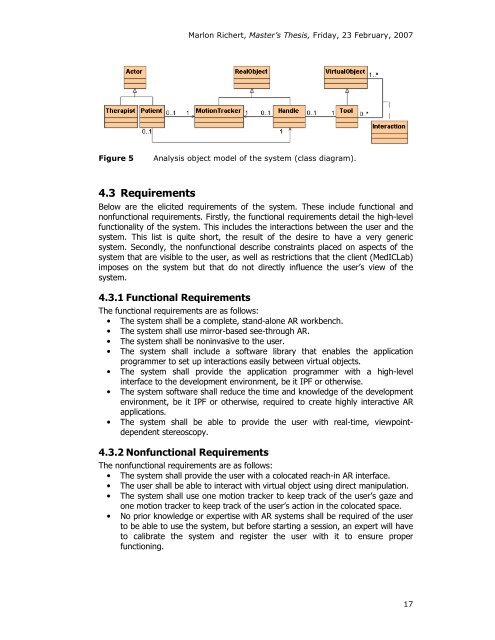The AR Workbench: A Complete Co-located Reach-in Mirror-Based ...
The AR Workbench: A Complete Co-located Reach-in Mirror-Based ...
The AR Workbench: A Complete Co-located Reach-in Mirror-Based ...
You also want an ePaper? Increase the reach of your titles
YUMPU automatically turns print PDFs into web optimized ePapers that Google loves.
Marlon Richert, Master’s <strong>The</strong>sis, Friday, 23 February, 2007<br />
Figure 5 Analysis object model of the system (class diagram).<br />
4.3 Requirements<br />
Below are the elicited requirements of the system. <strong>The</strong>se <strong>in</strong>clude functional and<br />
nonfunctional requirements. Firstly, the functional requirements detail the high-level<br />
functionality of the system. This <strong>in</strong>cludes the <strong>in</strong>teractions between the user and the<br />
system. This list is quite short, the result of the desire to have a very generic<br />
system. Secondly, the nonfunctional describe constra<strong>in</strong>ts placed on aspects of the<br />
system that are visible to the user, as well as restrictions that the client (MedICLab)<br />
imposes on the system but that do not directly <strong>in</strong>fluence the user’s view of the<br />
system.<br />
4.3.1 Functional Requirements<br />
<strong>The</strong> functional requirements are as follows:<br />
• <strong>The</strong> system shall be a complete, stand-alone <strong>AR</strong> workbench.<br />
• <strong>The</strong> system shall use mirror-based see-through <strong>AR</strong>.<br />
• <strong>The</strong> system shall be non<strong>in</strong>vasive to the user.<br />
• <strong>The</strong> system shall <strong>in</strong>clude a software library that enables the application<br />
programmer to set up <strong>in</strong>teractions easily between virtual objects.<br />
• <strong>The</strong> system shall provide the application programmer with a high-level<br />
<strong>in</strong>terface to the development environment, be it IPF or otherwise.<br />
• <strong>The</strong> system software shall reduce the time and knowledge of the development<br />
environment, be it IPF or otherwise, required to create highly <strong>in</strong>teractive <strong>AR</strong><br />
applications.<br />
• <strong>The</strong> system shall be able to provide the user with real-time, viewpo<strong>in</strong>tdependent<br />
stereoscopy.<br />
4.3.2 Nonfunctional Requirements<br />
<strong>The</strong> nonfunctional requirements are as follows:<br />
• <strong>The</strong> system shall provide the user with a co<strong>located</strong> reach-<strong>in</strong> <strong>AR</strong> <strong>in</strong>terface.<br />
• <strong>The</strong> user shall be able to <strong>in</strong>teract with virtual object us<strong>in</strong>g direct manipulation.<br />
• <strong>The</strong> system shall use one motion tracker to keep track of the user’s gaze and<br />
one motion tracker to keep track of the user’s action <strong>in</strong> the co<strong>located</strong> space.<br />
• No prior knowledge or expertise with <strong>AR</strong> systems shall be required of the user<br />
to be able to use the system, but before start<strong>in</strong>g a session, an expert will have<br />
to calibrate the system and register the user with it to ensure proper<br />
function<strong>in</strong>g.<br />
17
















